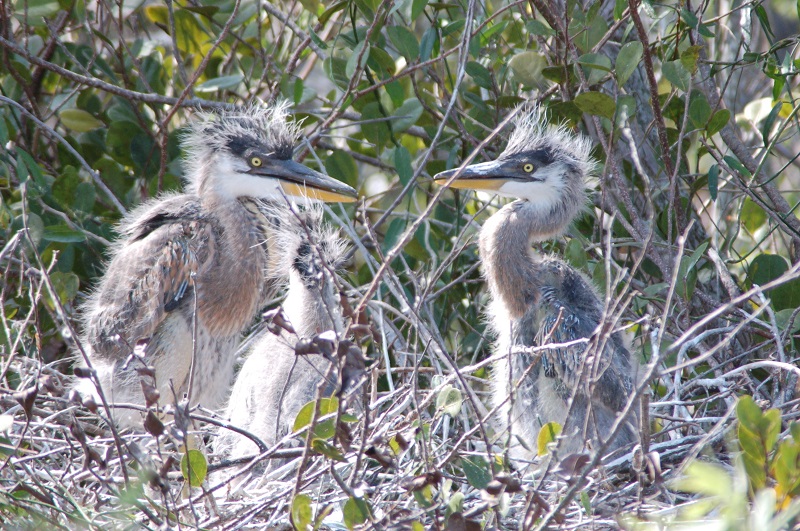
Photo by Willow Simmons.



Photo by Willow Simmons.
Spring—wildflowers are blooming and, for many animals, mating season has begun. Bucks are fighting for the attention of does and raccoon kits are everywhere. Great blue herons are no exception in this spring breeding frenzy and here I’ll introduce you these incredible birds and their lifecycle.

Herons are piscivores, meaning they are carnivores that primarily eat fish. Although they mainly consume fish, they will hunt small reptiles, amphibians, mammals, insects, invertebrates and crustaceans. Herons are usually seen hunting alone alongside water edges. When temperatures are below freezing, and water bodies inevitably freeze over, herons will venture to fields and ditches to hunt for food. Herons use their sharp beak like a spear, a fishing technique called a bill stab. They stand incredibly still and wait for a fish to swim close enough for them to impale, then swallow the catch whole.
Standing roughly 4 feet tall and weighing in at only 5 pounds, adult great blue herons are goose-sized birds often confused for a crane. True to their name, great blue herons are blueish gray in color with some white accents on the chest and mandible. Their beak and eyes are yellow and they have a dark gray cap of feathers on top of their head.
When mating season comes along in the spring a male will attempt to attract a mate by courting a female. Herons mate one to two times annually, so males have to make their efforts count. To signal a male wants to mate he flies with his head down and extended. A female will drop her head if she accepts his offer.

Once a mating pair of great blue herons have found one another it is time to build a nest. The Cornell Lab says the males gather sticks and various materials for the female to assemble a nest.
After the nest is complete, the heron’s mate and the female will lay a clutch of eggs. Most clutches contain two to five light blue eggs. Over the next month, both the male and female take care of the eggs, taking turns guarding the nest against predators looking to score an easy meal.
Great blue herons nest in groups with other breeding herons. These groups are called rookeries.
The Cornell Lab states there can be upwards of 500 nests in some rookeries. Why nest in such large groups you may ask? Herons nest in large colonies because there is safety in numbers. The more eyes on the lookout for predators the better. Adult herons do not have many predators; they are most at risk of becoming a meal when they are eggs. Hawks and raccoons will raid an unguarded nest and destroy the eggs.
Once the eggs hatch both male and female great blue herons share in the duties of incubating, feeding and raising their chicks. Baby herons are awkward balls of fluff when they first hatch but quickly grow into large, prehistoric-looking birds. According to the national Audubon Society, young birds are fully developed and capable of flight at two months of age. They leave the nest within the following days or weeks.
As young herons mature into adults their plumage changes with them. Juvenile great blue herons have pale abdomens with streaking colors of brown, gray and white on their chests. When they reach adulthood, their “blue form” plumage develops. Their wing tips turn dark and a patch of white down feathers grows on their chest. These specialized feathers are coated with a powder that herons wipe their feet and bill to absorb fish oil and slime.
Around a year of age great blue herons are old enough to reproduce. Every year great blue herons will find a new mate and the process of courting, hatching eggs and raising young repeats. Thanks to conservation efforts, great blue herons are of low concern conservation status, meaning that their numbers are stable But remember that you play a role in the health and well-being of wildlife, so be mindful of your impacts on the environment.
Willow Simmons works as a veterinarian technician and in her free time she practices wildlife photography. Her photography primarily focuses on southern Illinois wildlife where she is based.
Submit a question for the author